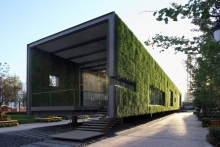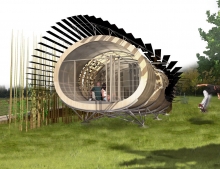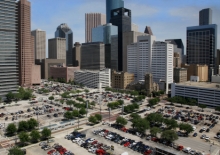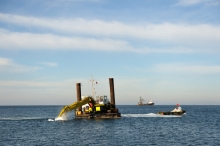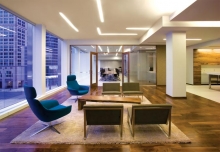Malmö, a city in southern Sweden that is connected by bridge to nearby Copenhagen, has undergone an amazing transformation over the last 20 years. What was a place at risk of becoming a post-industrial city in crisis has instead become a thriving inspiration for Sustainable Development. Apparently at least 20,000 international guests have been attracted to the city, not to experience Malmö as tourists, but to experience Malmö’s approach to environmentally friendly architecture and urban development. Malmö is the flagship of urban sustainability for Sweden and has won numerous awards for this commitment from the United Nations, Worldwatch Institute, and others.
Design News
Green Technology Showroom by Vector Architects
An unassuming giant box covered in green is camouflaged by surrounding trees and grass. Pedestrians hurrying by may take little notice of it, while some might curiously ask, “What is that?” It is a 2008 project called the Green Technology Showroom by Vector Architects that inhabits the central lawn of a residential compound in the Guanganmen district of Beijing, China.
Mending Myrtle Avenue: Pratt Institute's New Academic Building
Myrtle Hall by WASA/Studio A
Most town and gown relationships are tenuous, if not tense, but Pratt Institute in Brooklyn, New York, has made a welcoming gesture toward neighboring Clinton Hill in the form of a new academic building that reknits the urban fabric. The new six-story, 120,000 sq. ft. (approximately 11,148 m2) Myrtle Hall is expected to achieve LEED Gold certification, and it will house the Institute's Department of Digital Arts, including studios, galleries, classrooms, labs, and administrative space.
LifeCycle Tower: Taking Wood to New Heights
Metal and concrete, along with various composite materials, are the definitive building blocks of contemporary architecture. Wood is more historic and homespun … or is it? For almost every green attribute that these trendier materials can boast, wood can boast one of its own. Most notably, wood is renewable, it represents low embodied energy, and it sequesters carbon for as long as it is in use as a building component. The designers of the LifeCycle Tower are setting out to prove that wood can be used for more than just homebuilding.
The Olympics of Green Design: The 2011 Solar Decathlon
It's a competition of Olympic proportions, but can an event dedicated to piquing public interest in alternative energy technologies draw crowds like a sporting event? The Solar Decathlon is a biennial competition established in 2002 and supported by the U.S. Department of Energy and the National Renewable Energy Laboratory (NREL). Twenty teams from colleges and universities around the world are selected to design and build solar-powered homes over the course of the two-year period. This fall, the 2011 teams will showcase their homes in Washington, D.C., for 10 days with free admission to the public. Visitors will learn about sustainable design and hopefully find inspiration to incorporate some strategies into their own homes. Following the competition, the houses will be sold to families or developers, used for research, or displayed at their respective universities.
2011 Solar Decathlon: Team Hawaii
Hale Pilihonua Connects Home, Land, and Sea
When most people picture Hawaii, pristine beaches and sparkling blue waters come to mind. teamhawai'i aims to preserve this image for future generations. For the first time, the University of Hawaii was selected to participate as one of the 20 teams in the 2011 Solar Decathlon, sponsored by the U.S. Department of Energy and the National Renewable Energy Laboratory (NREL). Previously, Universidad de Puerto Rico was the only tropics-based team to participate, although this climate type comprises 40% of the Earth's surface. Not only has teamhawai'i strived to create a design that addresses the unique challenges presented by the tropics, but they also hope to cultivate and retain local talent.
The State of Indian Architecture
“A tradition has been broken in Indian architecture. Too much has intervened, and modernity, or what is considered to be modernity, has now to be swallowed as a whole. Year by year, India's stock of barely usable buildings grows. Old ideas about ventilation are out, modern air conditioners are in. They absolve the architect of the need to design for difficult climate, and leave him free to copy.” – V. S. Naipaul
At the 2011 International Builders’ Show, teams participating in the U.S. Department of Energy Solar Decathlon gathered to showcase their designs and to spread the word about the competition. While in attendance at the show, we had the opportunity to meet the Appalachian State University team and learn more about the Solar Homestead, their entry into Solar Decathlon 2011. Collaboration and excitement at the opportunity to change the way homes are built were apparent. Join us as we follow the Appalachian State University team in the first of a series of videos documenting the Solar Homestead project.
Investing in Carbon Offsets
In recent years, the world of real estate has focused on sustainability, and rightfully so. According to the U.S. Green Building Council, buildings account for 40% of primary energy use in the United States, as well as 39% of its carbon dioxide emissions. These numbers have played a part in the industry’s drive toward green building. Owners are no longer content with traditional energy use and the negative impact that it has. Building owners have identified tangible returns to going green, including increased marketability, decreased operating costs, and the halo effect. These returns create an opportunity for carbon offset investments.
Is Parking Policy Stunting Urban Sustainability?
If you had to run to the store a few blocks down to pick up a gallon of milk, would you throw on your walking shoes, or would you drive? Some will relish the opportunity to get a little fresh air and exercise. More often than not, however, the majority of us will drive. If parking cost a dollar at the grocery store, however, would you make the same decision? This is the phenomenon being explored by many urban planning experts these days, including Donald Shoup, author of The High Cost of Free Parking and staunch critic of the policies dictating those expansive asphalt plains covering urban areas throughout the United States. Shoup decries parking requirements for a variety of reasons, and his 681-page volume can hardly be summarized in this article. Some key points, however, are of great interest to anyone interested in the sustainability of our urban areas, our citizens, or the environment at large.
Underwater Construction
The term “underwater construction” or “commercial diving” covers a wide array of activities. At the core, underwater construction is simply industrial construction that happens to take place under water. Activities vary greatly but include bridge inspection, building repair, repair of wastewater treatment facilities, and equipment installation.
Fresh Perspectives on Sustainable Office Space
Without a doubt, including sustainable values in corporate identity and branding can increase demand, but embracing and executing these values is a whole other game. We talked with Sara Rothholz Weiner of the Minneapolis architectural firm Cuningham Group, which is responsible for leading the design team for Nilan Johnson Lewis, P.A. This Minneapolis law firm sought to discover how sustainability practices can be implemented by professional office space in a way that is effective and entirely comprehensive. Weiner provided us with insight on how sustainable integrity can be both genuine and positively beautiful.

